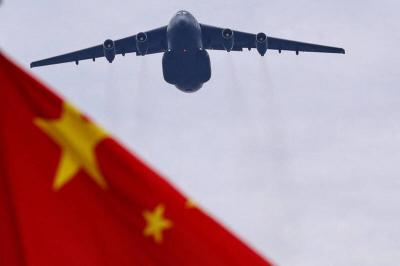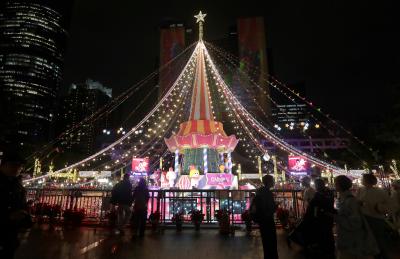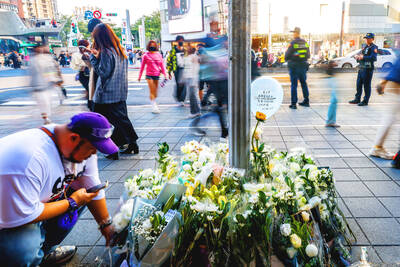The dramatic standoff between dozens of Taiwanese fishing boats, Coast Guard Administration (CGA) vessels and Japanese patrol ships near the disputed Diaoyutai Islands (釣魚台) on Tuesday morning made global headlines and fueled speculation that President Ma Ying-jeou’s (馬英九) administration may have orchestrated the incident to divert attention from domestic issues or to do Beijing’s work. However, observers said that things are not that simple.
Following the announcement by Tokyo on Sept. 11 that it had nationalized three islets in the Diaoyutais — known as the Senkakus in Japan — Taipei and Beijing, which both claim the island chain, protested the move, which had generated violent demonstrations across China and a much smaller rally in Taipei on Sunday.
On Sept. 20, the Suao Fishermen’s Association in Yilan County announced that several dozen Taiwanese fishing boats would set sail for the Diaoyutais on Monday to protest against what they called Japan’s “illegal occupation” of the island group and “harassment of fishermen” around the islands.
Although the Yilan County Government, headed by Commissioner Lin Tsung-hsien (林聰賢) of the Democratic Progressive Party (DPP), turned down a request for NT$5 million (US$170,000) in fuel subsidies for the fishermen, the sortie was eventually made possible by a donation of that amount by Want Want China Times Group chairman Tsai Eng-meng (蔡衍明), who has often been portrayed as pro-China.
Also fueling speculation that the Chinese Nationalist Party (KMT) had plotted the sortie to create a diversion was the role played by Suao District 2 Administrator Hong Hsiu-tsao (洪秀璪) of the KMT, who took part in the event.
Hong told a Japanese reporter that the issue was not whether one likes Japan or not, but one of fishing rights.
However, Ketty Chen (陳婉宜), a political scientist at National Taiwan University who studies KMT political activity, says the requirement for politicians to meet the needs of their constituents, rather than directives from the central party committee or party ideology, helped explain Hong’s role.
“Even if the local KMT participated in the sortie, this does not mean that the KMT ‘orchestrated’ the whole thing,” she said, adding that fishermen constituencies have historically been close to the KMT.
“We therefore can’t assume that Ma told Hong to go,” Chen said.
Despite turning down the request for financial assistance, the county government sent rescue ships to assist with supplies, and in a statement, Lin, who reportedly had wanted to accompany the fishermen, but was barred by the DPP from doing so, commended the fishermen for their “bravery” and “determination.”
Again, this shows that “politicians will go where their constituents and supporters go,” Chen said.
Journalists who were present at Suao prior to the departure on Monday also reported that the fishermen said they were only interested in protecting their fishing rights and had little interest in China or politics. The T-shirts they wore and the banners on the boats carried messages about issues of livelihood and fishing rights, not sovereignty.
The Suao and Keelung fishermen’s associations also stayed clear of the protest in Taipei on Sunday, where about 1,500 people, including organizations calling for cross-strait cooperation, clamored for the Republic of China’s (ROC) sovereignty over the Diaoyutais.
Chen Chun-sheng (陳君聖), president of the Suao Fishermen’s Association in Yilan County, said last week that the association’s members had a different agenda, which was to secure their fishing rights.
The sovereignty issue should be handled by the government, he said.
The Chunghua Baodiao Alliance, a more nationalistic group with ties to Hong Kong and China, did not participate in the sortie, saying its presence would have complicated matters.
Meanwhile, in Taipei, the KMT and the Presidential Office commended the fishermen for their patriotism and emphasized the public’s initiative, casting doubt on the notion that Tuesday’s events were directed from Taipei.
The KMT was also conspicuously absent from the protest on Sunday.
Lin Yu-siang (林鈺祥), an adviser to the Institute for National Policy Research and a former KMT legislator, said KMT members did not want to align themselves with the protesters.
“Those are the pro-China, unificationists; it is not us,” he said.
The fishermen were out to protect their interests and for them the issue was not sovereignty, Lin Yu-siang said, adding that the KMT would not be able to motivate the fishermen to head to Diaoyutais to defend ROC sovereignty “even if they paid them NT$100 million.”
Although the central government could have prevented the fishermen from heading for the Diaoyutais, as it has done in the past, local pressure from fishermen’s associations compelled it to allow them to set sail. After that, the government had no choice but to dispatch coast guard vessels to ensure their safety.
“What is the coast guard supposed to do in such a case, nothing?” Chen asked.
Tsai’s donation to the fishermen also spoke more to his roots than ideology. The Yilan-born entrepreneur, who prior to making his fortune in the crackers business worked in the canned fish industry, said he provided the money because people should not regard Taiwanese as “weaklings.”
Never missing an opportunity, Tsai also had a company banner affixed to one of the boats.
Lin Yu-siang said the fishermen committed a strategic error bt accepting money from Tsai because of his close association with China. Taking money from Tsai gives the Japanese and the pan-green camp the excuse to imply that China was behind the whole thing and that Ma is doing China’s dirty work, he said.
All of this shows that the issue is very complex, with overlapping and sometimes conflicting mandates, Chen said.
“It’s not black and white,” she said.

Beijing could eventually see a full amphibious invasion of Taiwan as the only "prudent" way to bring about unification, the US Department of Defense said in a newly released annual report to Congress. The Pentagon's "Annual Report to Congress: Military and Security Developments Involving the People's Republic of China 2025," was in many ways similar to last year’s report but reorganized the analysis of the options China has to take over Taiwan. Generally, according to the report, Chinese leaders view the People's Liberation Army's (PLA) capabilities for a Taiwan campaign as improving, but they remain uncertain about its readiness to successfully seize

Taiwan is getting a day off on Christmas for the first time in 25 years. The change comes after opposition parties passed a law earlier this year to add or restore five public holidays, including Constitution Day, which falls on today, Dec. 25. The day marks the 1947 adoption of the constitution of the Republic of China, as the government in Taipei is formally known. Back then the Chinese Nationalist Party (KMT) governed China from Nanjing. When the KMT, now an opposition party in Taiwan, passed the legislation on holidays, it said that they would help “commemorate the history of national development.” That

Taiwan has overtaken South Korea this year in per capita income for the first time in 23 years, IMF data showed. Per capita income is a nation’s GDP divided by the total population, used to compare average wealth levels across countries. Taiwan also beat Japan this year on per capita income, after surpassing it for the first time last year, US magazine Newsweek reported yesterday. Across Asia, Taiwan ranked fourth for per capita income at US$37,827 this year due to sustained economic growth, the report said. In the top three spots were Singapore, Macau and Hong Kong, it said. South

HORROR STORIES: One victim recounted not realizing they had been stabbed and seeing people bleeding, while another recalled breaking down in tears after fleeing A man on Friday died after he tried to fight the knife-wielding suspect who went on a stabbing spree near two of Taipei’s busiest metro stations, Taipei Mayor Chiang Wan-an (蔣萬安) said. The 57-year-old man, identified by his family name, Yu (余), encountered the suspect at Exit M7 of Taipei Main Station and immediately tried to stop him, but was fatally wounded and later died, Chiang said, calling the incident “heartbreaking.” Yu’s family would receive at least NT$5 million (US$158,584) in compensation through the Taipei Rapid Transit Corp’s (TRTC) insurance coverage, he said after convening an emergency security response meeting yesterday morning. National